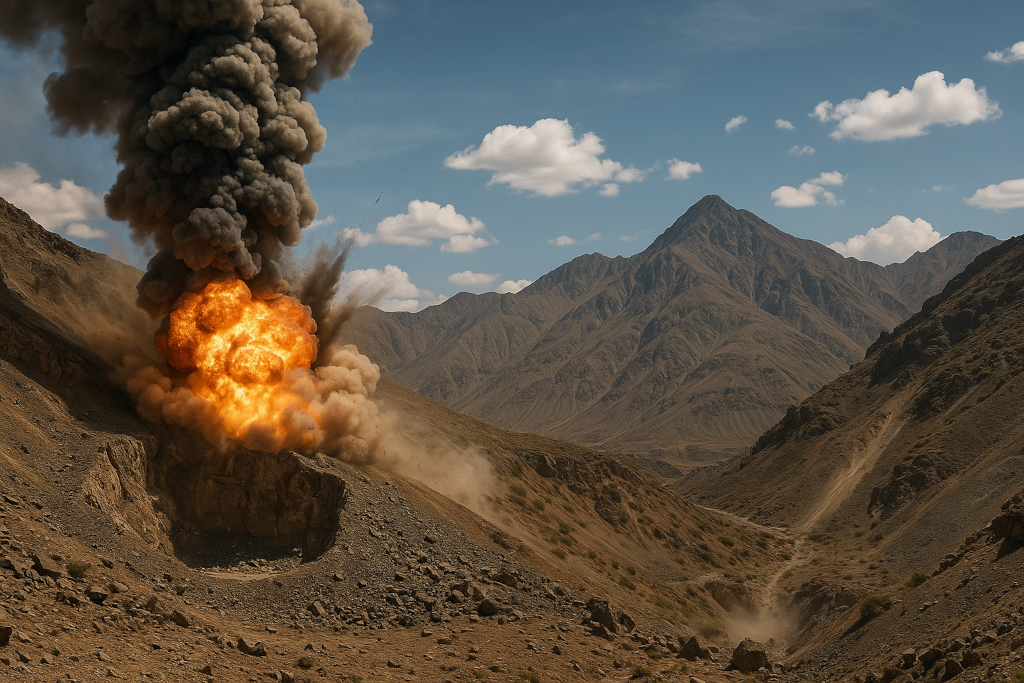We’ve all seen the movie scenes—massive explosions rattle entire mountain ranges, shockwaves ripple through the earth, and somewhere, seismic alarms start blaring. Dramatic? Absolutely. Scientifically accurate? Not even close.
But here’s the real question—can bombing a mountain, particularly in a place as seismically active as Iran, actually cause an earthquake?
It’s the kind of idea that feels intuitive. Big bangs shake the ground. Earthquakes shake the ground. So, hitting a mountain with a powerful bomb must mean we’re flirting with a tectonic trigger, right?
Turns out, the truth is both less dramatic and far more interesting.
When explosions meet geology
Let’s talk about bunker-buster bombs for a second. These are not your average explosives. The U.S. Massive Ordnance Penetrator (MOP), for example, can burrow tens of meters into solid rock before detonating, designed specifically to destroy underground facilities like bunkers or tunnels.
So, what happens to the Earth when these go off?
- Localized damage: The immediate area suffers craters, rock collapses, and landslides. Tunnels may cave in, and nearby surface structures could be destroyed.
- Detectable seismic signals: Seismometers do pick up these explosions, but they show up very differently from natural earthquakes—more like sharp, high-frequency “spikes” rather than rolling tectonic waves.
- No chain-reaction chaos: Most importantly, no matter how deep or powerful the bomb is, it simply can’t release enough energy to affect fault lines kilometers underground.
Why don’t bombs trigger earthquakes?
The idea of human-induced earthquakes isn’t entirely fictional—some types of mining, oil extraction, and even underground nuclear testing have been linked to seismic activity. But what sets those apart from military bombings?
It comes down to scale and depth. Tectonic earthquakes occur when stress builds up in the Earth’s crust miles below the surface—often 5 to 20 kilometers deep—until the rock finally snaps along a fault. Even a “small” magnitude-4 quake releases thousands of times more energy than a bunker-buster explosion.
According to seismic monitoring stations and satellite imagery, recent bombings of nuclear-related mountain facilities in Iran caused visible destruction—craters, tunnel blockages, and rockslides. But there was one major thing missing: earthquakes.
Seismic data collected during these attacks consistently showed localized ground shaking without any evidence of fault rupture or widespread stress release. In short, nothing that even resembles a tectonic earthquake happened.
Past bombing events: What history tells us
To put this in perspective, consider the U.S. underground nuclear tests during the Cold War. Detonations like the 1962 “Sedan” test released magnitudes comparable to earthquakes. Even with that force—equivalent to a magnitude-4 quake—the effects remained incredibly local, with no triggered tectonic events nearby.
Contrast that with Iran’s mountain ranges, which sit on fault lines like the major Zagros and Alborz zones. Earthquakes originating here come from deep fault movements caused by continental plate shifts—forces far beyond our control or capacity to replicate with weapons.
The bottom line: Explosive myths vs. earthquake math
No matter how dramatic it sounds (or looks in an action flick), dropping bombs on a mountain—even in an earthquake-prone country like Iran—doesn’t spark tectonic activity.
So next time you see a high-resolution satellite image of a crater and wonder, “Could that cause the next big quake?”—you’ll know better. The seismological effects stay local: shaking, surface damage, and maybe some landslides. But triggering a full-blown earthquake? Not a chance.
Final thought
The Earth is a powerful machine. Its fault lines shift under stresses accumulated for centuries, not because of a few tons of TNT. That’s both terrifying and reassuring. Our explosives may be massive, but the Earth’s tectonic might still dwarfs them by eons.
So let’s set the record straight: Bombs may scar the surface, but earthquakes come from much deeper battles underground.




1 Comment